All posts by John Rodriguez
Keep It, Leave It, Want It
Keep It, Leave It, Want It
- I really like the work we’re doing in regards to stories, memory, and how we remember things in distorted/different ways just by the mere nature of how our minds work. I really think we could continue pushing these ideas especially if we move toward a more narrative-based performance or pieces. Perhaps we should look for ways to expand on certain performances or bring different objects together under a larger narrative or performance.
- I feel like we haven’t really done much with the theme of “Shit of Everyday Life” or if we have, it’s always taken second-place to a different theme or a broader idea and doesn’t really come through all that well. I would say this would be an opportunity to explore something more in depth, but I feel like we aren’t all that interested in it to begin with and we’re gravitating toward themes that seem much more interesting to us. Maybe we can continue to come back to it in other ways, but for right now I think we should drop it as a major theme/priority.
- I feel like we’ve talked a lot about failures—different kinds of failures, different ways of failing, authentic versus non-authentic failure, etc.—but we haven’t talked much about success. Now, I know success is boring and probably wouldn’t be as interesting to explore as failure, but I feel like it would be a good counterpoint with which to think about failure more deeply. We may not necessarily have to create any sort of performance or object to be shown in public, but we might think of success in order to think more critically about what it means to fail and what different kinds of failures mean.
WIP #1 – Reflections
Personal Reflections
- I really thought the “Human Again” piece worked really well as the introduction to the whole showing. It worked very well given the amount of people. I was very surprised to find that no one actively stopped participating by taking off their blindfolds or sitting down, etc. They went along with it to the very end.
- The beginning of the exhibition was really chaotic. At some point, I remember hearing all the exhibits kind of coming to life at once and hearing barking from one place, shouting from another, reading from one, music from another. It felt like a very very distinct shift in tone from the “Human Again” piece to that–which maybe worked or maybe didn’t for each particular audience member.
- I think spatially the exhibits were organized really really well! The room felt like it had a natural flow. Not in the sense that the objects all shared a similar goal, theme, relationship, etc, (because that wasn’t our goal) rather, it just all worked together in the space correctly. Also, all the performances seemed to work very well in their adjusted locations.
Guest Reflections
What Worked/What Didn’t Work
- Bailey’s box was a draw. One of them did enjoy it (mainly “because I got food.”) while the other one did not even approach it because she felt really uncomfortable about “him just wearing underwear and no shoes.”
- Omar’s Enraged Edibles was a hit. They both thought it was funny, but also very poignant in the way it addressed/handled issues “we’ve all learned of and have been exposed to.”
- Other notable favorites were Paige’s “Adam + Eve” video and Phoebe’s “Law & Order” performance.
- Carina’s Syrian refugee crisis performance was a source of confusion for both of my guests, but it was interesting to watch/listen to them try to figure out what it meant because after about 5 minutes of bouncing ideas of each other they decided that it had to be about the Syrian refugee crisis.
General Thoughts
- The performances were better than the objects. They felt more important or pressing than the static gallery pieces especially if they had to get moved around from location to location.
- They enjoyed the performances and being moved around much more than the free time in the gallery because it felt like it gave them more purpose.
- Preferred having clear instructions on what they had to be doing either by being moved around for a performance or by seeing a sign. One of my guests was willing to interact with anything and tried to see it all. The other guest was only willing to interact with objects that had explicit instructions like “watch me” or “taste me”, but not with the more abstract or unguided ones.
- “I didn’t know if we were allowed to interact with each other or talk in the beginnin.” But after a while they both agreed that they felt more comfortable doing so. And after they talked to people, they felt more comfortable doing different things and seeing the objects.
- They had no clue what our (the class) role was in the whole thing. Were we actors? Were we showing them how to interact with things?
- They felt like it was too chaotic early on, but that things mellowed out as they went along.
Reflect + Write
Themes/Groupings
- Traveling to unknown or faraway or new or mysterious places
- Maps and cartography, ELI5 (Molly)
- The Party Express, ticket & train whistle (Phoebe)
- Gregor McGregor, ELI5 and performance (David)
- Midnight NYC (John)
- Highway to Hell (John)
- Hotels Across the Country (John)
- Power of remembrance
- How memory works, ELI5 & performance (Phoebe)
- Easter, 1996 (Gabrielle)
- Goodnight, Soldier (Gabrielle)
- Short-Term Memory (John)
- Picture of the Stars, story and image (John)
- Juxtapositions (Sarah)
- Love in its many different incarnations like bad love, funny love, hurtful love, love that we will never forget, love that we wish we could get back
- Hotels Across the Country (John) & the original drawing by Paige
- Lolita (Paige)
- 3 Dates & a Wedding, the whole story but also the arrangement of the cards on the board (Gabrielle)
- The Origin of Love, Story #5 (Molly)
- Adam and Eve (Molly)
- You & Me (John)
- “Love is…” Juxtapositions (Gabrielle)
- Poem about mom in Story #3, The Land Before Time (Omar)
- Live forever (Bailey)
- Once in the Highlands, Story #4 (Kimmy)
- Don’t Forget Your Mission, Story #3 (Kimmy)
- A Kiss for the Heart to Grow, Story #1 (Kimmy)
- Us, Story #4 (Paige)
- Short-Term Memory (John)
- Spirituality & Religion
- Gnosticism (Sofia)
- Syrian refugee crisis (Carina)
- Feng shui, ELI5 & performance (Paige)
- Cosmogeny (Sofia)
- Historical figures, groups, events and its interaction with the present
- Gregor McGregor (David)
- Black Panther Party, ELI5 & performance (Kimmy)
- Syrian refugee crisis, ELI5 & performance (Carina)
- Maps and cartography, ELI5 (Molly)
- The Federalist Papers, ELI5 & performance (Sarah)
- The Baker, senses (Bailey)
- We have a slight obsession with food, especially weird seemingly out-of-place food
- Bailey’s homemade Roman-era bread (Bailey)
- Brownies with Raisins (Phoebe)
- Tea with nutmeg (Sofia)
- Whipped cream with red pepper flakes (Carina)
- Cocoa powder & salt (Maddie)
- Story #1, Kraft (Omar)
Objects from My Own Work
- Story #4: Short-Term Memory, Object 4: Remember Me, Please
- Juxtapositions: Hotels Across the Country
— There’s something really powerful about the way in which we remember the loves we’ve experienced—like the loves we never had, the loves that hurt us, the loves that made us happy, or sad, or cry and everything in between—no matter what we go through in life.
Objects from Other People’s Work
- 3 Dates & a Wedding (Gabrielle)
- Show, Don’t Tell: How Memory Works (Phoebe)
- Show, Don’t Tell: Hiccups (Bailey)
- Juxtapositions: “Love is…” (Gabrielle)
— I was very drawn to the way that a story changes and can be told depending on how you arrange objects, people, and your audience in space and in relation to one another.
Show, Don’t Tell: Electric Bicycles
Object 1: Highway to Hell
- ft. The Serendipitous Addition of John Laughing While Blowing Up Balloons
Object 2: Hair-Rising Electricity
- Since it was dark, there really wasn’t a way to record this event, but the idea is simple. Just blow up a balloon and rub it on your arm. Then, pass it over someone else’s arm and see/feel their arm hair rise because of the static electricity.
Object 3: A Million Volts
Five Senses: The Central Limit Theorem
Fact: As your sample size increases to a reasonably large amount, the sample will reach a normal distribution, centered on the mean, regardless of what the actual population distribution looks like.
Sight: A Fractal in Motion
- Play around with the settings of the fractal generator and see how small shapes can generate fascinating and intricate designs.
Sound: Gradual Symphony
Touch: Harmony

- NOTE: I was going to take a picture of the sign I made, but I accidentally lost it. So I’ve included a picture of what the braille arrangement was in the event we need to recreate it.
- A handmade sign in braille that reads (hopefully…) “Harmony”. While each individual bump might feel insignificant or like nothing more than a small pebble in a mound of sand, taken together they create something entirely different and meaningful. They’re a whole lot more than the sum of its individual parts.
Smell: Is This a Febreeze Commercial?
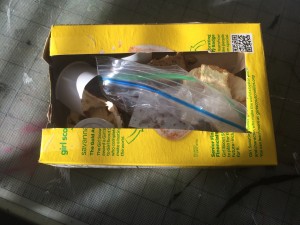
- Here’s a bunch of gross, sad things that came together and became something entirely different once I joined them together in a mist of clean-smelling, soothing Febreeze.
Taste/Combination: Trail Mix
[INSERT TRAIL MIX IMAGE HERE]
- TFW you can’t go to Walmart, so you have to improvise a trail mix by combining different cereals and granola to create a mixture that tastes, sounds, and looks really great!
A Sixth Grader’s Report on Electric Bicycles
Electric Bicycles
When we talk about bicycles we usually imagine a network of metal rods, pedals, and wheels that someone drives along with their own leg strength. But, you would be surprised to know that there’s actually a whole world of bicycles out there that most people know little about! When you say “electric bicycle” people usually imagine a motorized scooter or even a motorcycle, but in reality electric bicycles are nowhere near close to that image. Most electric bicycles are simply standard bicycles equipped with a variety of electric components that are arranged in sync with the design. They are equipped with a battery, a motor, and a controller to charge the battery. The motorized components are not meant to replace human power, but instead they work with it to augment the total speed and power of the bike (EVELO, 2016). That means, you still have to pedal on an electric bike and steer like you would on any other bike. The oldest patent for an electric bike is by Ogden Bolton, Jr. of Canton, Ohio, which was filed in September 1895 and granted three months later (EVELO, 2016).
You might be wondering why anyone would need an electric bike to begin with. Why not just get a regular bicycle like everyone else and save the money? For some people, like the elderly or persons with disabilities, electric bicycles present an opportunity to use the standard mechanism of a bicycle without the entire physical strain of a normal, non-electric bicycle (Woodford, 2015). Plus, you can travel a lot farther without getting as tired as you would on a regular bike and it makes obstacles like hills a lot easier to manage. They also present a lot of additional conveniences than a regular bike—like faster speed—with the same economy and overall environmental-friendliness.
Electric bicycles have three main parts to them: a battery, a frame, and a motor (Woodford, 2015). The battery contains all the power that will drive the bike along. In theory, you could use any kind of battery on a bicycle. But, in reality, you want to use a battery that stores a lot of power without being too heavy or bulky. Otherwise, you’ll be wasting all your power just trying to drag the weight of the battery. A standard electric bike battery makes about 350–500 watts of power, which is about a quarter as much as you need to power a toaster (which doesn’t really help me understand any better how much power that actually is…) (Woodford, 2015). Lightweight lithium-ion batteries, similar to those used in laptops and cellphones are now the most popular choice—granted they’re pretty pricey. A standard battery provides you with a range of 10–40 miles between charges (depending on the terrain) and a top speed of 10–20 mph. Although you can extend the range by simply pedaling more or free-wheeling along. You can typically tell an electric bicycle by its somewhat obvious battery pack mounted on the main frame (Woodford, 2015) (EVELO, 2016).
The next part of the electric bicycle is the frame. Electric bikes have a different frame than those of regular bicycles. The main part of the frame, which supports the majority of your weight, is made from lightweight aluminum alloy. The golden rule for electric bike frames is this: The lighter the frame, the lighter the weight of the bike overall. And the lighter the bike is, the longer you can travel without having to charge the battery. The battery that powers the electric bike is usually placed somewhere on the main frame to help balance the overall weight of the bike (Woodford, 2015).
The last part of the bicycle is the motor. The two kinds of motors are full-power motors and power-assist motors. Full-power motors are designed to reduce the amount of pedaling you do over a shorter amount of distance. They have large batteries and powerful motors, but also, as a result, tend to be bigger and heavier. Since the battery is engaged at all times and you provide no pedaling power, the range is limited to around 10–20 miles (Woodford, 2015). Power-assist motors (also known as pedal-assist motors) are the equivalent to hybrid cars. They are meant to be pedaled by you for the most part and are only really electrically-powered if you are too tired or if you are facing a big obstacle like a hill. Unlike full-power bikes, they don’t have a hub motor. Instead, there’s a separate motor mounted near the rear wheel that is significantly less bulky and lighter than a hub motor. Power-assist motors turn easily with little to no resistance when you pedal because the bicycle does not have a large hub motor dragging it down with its weight. They also have a much greater range than full-power motors going from 50–90 miles (Woodford, 2015) (EVELO, 2016).
Electric cars are certainly better than regular old cars, but they also aren’t the best thing out there when it comes to environmentally-friendly types of transportation. For one, batteries are a major source of pollution across the world. Their production and disposal leak harmful contaminants and chemicals into the environment. An electric bicycle also has to be charged using electricity that could have been produced in any number of environmentally-harmful ways. Electric bikes are certainly not better than regular, standard bikes because they require the production and use of potentially-unclean energy to run. But, if everyone used an electric bike instead of a car, pollution would be significantly less than its current state (Woodford, 2015).
In conclusion, electric bicycles are a relatively unknown part of the bicycle world. They consist of a battery, a frame, and a motor. Running on the power of a battery, electric bicycles allow you to travel faster than you could on a regular bicycle. They also present a good alternative for bicycle-riding for the elderly or persons with disabilities. While they present a good alternative, electric bicycles can also be potentially harmful for the environment. Because of the production and use of a battery and the need for electricity, electric bicycles can contribute to dangerous pollution across the world.
Works Cited
EVELO. “Electric BIkes 101 – Electric Bicycles: What They Are & How They Work.” EVELO Electric Bicycles. Web. 17 Feb. 2016. <http://www.evelo.com/electric-bikes-101/>.
Tyley, Jodie. “How Do Electric Bikes Work?” How It Works Magazine. 19 July 2011. Web. 17 Feb. 2016. <http://www.howitworksdaily.com/how-do-electric-bikes-work/>.
Woodford, Chris. “Electric Bicycles.” ExplainThatStuff. 16 Oct. 2015. Web. 17 Feb. 2016. <http://www.explainthatstuff.com/electricbikes.html>
Juxtapositions: Hotels Across the Country
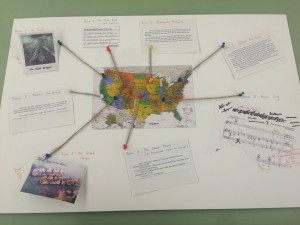
Hotels Across the Country
Room 1 – Upstate New York
Comedy night at the Marquis was never any good. But he was from out of town and he didn’t know any better so I let him take me there anyway. Turns out, it’s not half bad when you’re with someone you like.
I’m not sure if I can call this love just yet, but it feels different. I don’t know, maybe I’ve seen one too many love stories. Or maybe I haven’t seen enough. You know what I hate about them? At the end of the movie, no one ever says what love is. The characters just fall in love and get married and then the credits roll. No definition, no answer, just a kiss and a blackout. What kind of bullshit is that? How the hell am I supposed to know when I’m in love if no one tells me what it actually means to be in love?
Whatever… I’m sure one day I’ll figure it out. Maybe one day he’ll come back and then I’ll know for sure.
Room 2 – Minneapolis, Minnesota
She saw me from across the street. Don’t ask me how, but she did. And I knew the moment I saw her that she would be the source of all my happiness. And then, my bus soared away and she disappeared into my hindsight.
I always take the same bus home, but that night I didn’t. And now I can’t go back to my old route again. I come back to that same stop at the same corner, across from the same hotel, hoping that I’ll see her again.
But, somewhere deep down, I know that I’m really waiting for her to see me.
Room 3 – The Great Plains (Or Somewhere Close to Kansas)
“Draw me a picture of the stars,” she said. I held her close and promised her I would.
But the next day, I forgot what the stars looked like. And pretty soon, I forgot what she looked like too.
“Draw me a picture of the stars,” I said. She held me close and promised me she would.
“One day, you’ll see them too.”
Room 4 – The Quiet B&B in Opal, Wyoming
From a note left at the front desk upon departure: “The service and food was lovely. And, if anyone ever asks, the scratches on my husband’s back came from all your cats. HaHaHa!”
Room 5 – The Grand Canyon
From a postcard sent home on August 16th, 2003: “We got on the road with nothing but $200 bucks for gas and a bunch of old snacks. 526 miles later and we made it! We have no idea where we’re going to stay, but this isn’t a bad place to be stuck in at all. You should come visit soon!”
Room 6 – The Pacific Northwest
From the back of a Polaroid found in the room trash: “This place feels like infinity. He says he never wants to leave.”
Room 7 – Motel California
California is the place of dreams. I guess that’s why we ended up in a cheap motel 2,000 miles away from home. No money, no car, but plenty of hope. But my mother used to say, “You can’t live in a fantasy forever.”
Good thing we made ours a reality before the clock stopped ticking.
Room 8 – Music City
From a scrap of a music sheet found in the back of a desk drawer: “Lobby of Hermitage. 9pm. Bring your best suit and a smile. See you soon!”
Story 5: You & Me
Object 1 – The World & Us
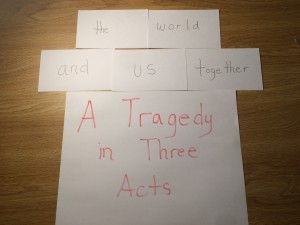
Object 2 – Act I
He crashed into me. Literally. We met when his car rear ended mine in the middle of bottleneck traffic during Manhattan rush hour. He bought me a cup of coffee while the cops came. And by the time they did, we were gone. Panting and out of breath we raced down the street and out of the city. We didn’t know where we were going.
And that was okay.
Object 3 – Act 2
He gets calls every day. They’re looking for us. People need us to return to reality. People want us to return to reality. But all we want is each other and this fantasy. He promises we’ll be fine. So do I. And it is fine. For ten years, it’s all fine and we live happily together. We adopt a kid. We buy a house. We get married. It’s all worked out. People stop needing us to return to reality. People don’t want us to return to reality. This is our reality.
And it was all okay.
Object 4 – Act 3
Until we gave up.
Object 5 – Dead End Love
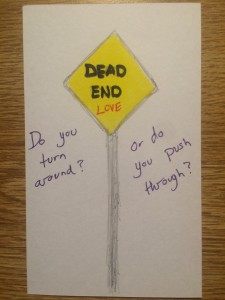
Object 6 – Is This What Love Feels Like?

Object 7 – The Catalyst
Love is the catalyst for human endeavor, in all its forms. If it wasn’t for the love of comedy, we wouldn’t have comedians to tell us why it’s so stupid to be in love. If it wasn’t for the love of science, we would have no chemists or biologists to tell us that love is nothing but a series of chemical responses in the body. If it wasn’t for love, we would have no reason to attend our sister’s wedding and meet the one person who can treat us how we deserve to be treated – like humans. When we don’t spend our lives doing what we love most, we can’t laugh. When we can’t laugh, we can’t love. And when we can’t love, we break that subtle harmony of the universe.
Object 8 – A Recipe for Love
A Recipe for Love
Serves 2
1 cup of passion
2 cups of dedication
¼ cup of constructive argumentation, finely chopped
½ cup of laughter
1 teaspoon of serendipity
1 tablespoon of adventure
1 cup of personal growth
1 ½ cups of shared experiences
¼ teaspoon of uncertainty, rough chop
¼ teaspoon tears, happy and sad combined
Memories and laughter, to taste
Instructions: Combine, stir gently, and cook until all is well done. Serve warm.
Object 9 – A Quick Poem on Love
Like an ocean breeze,
on a warm summer’s day, that’s
veering its way across the sprawling shoreline
each time finding its way back to the sea
That is how my love for you exists,
in endless motion,
always returning to you no matter how far we wander.
Object 10 – Let Go
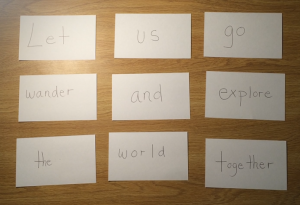
Story 4: Short-Term Memory
Object 1 – Ruby Ring
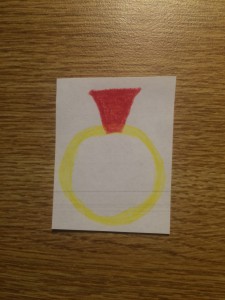
Object 2 – Casual Encounters
Object 3 – Question of the Day
Every morning for the rest of your life, when you wake up you will only remember one thing about your life. What do you choose to remember?
Object 4 – Remember Me, Please
Object 5 – A Picture of the Stars
“Draw me a picture of the stars,” she said. I held her close and promised her I would.
But the next day, I forgot what the stars looked like. And pretty soon, I forgot what she looked like too.
“Draw me a picture of the stars,” I said. She held me close and promised me she would, “You’ll be with them soon.”
Object 6 – The Picture of the Stars
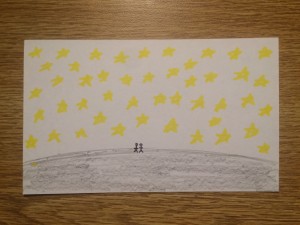
Object 7 – Describing Stars
A list of words to describe the stars:
- Radiant
- Glowing
- Bright
- Focused
- Distant
- Eternal
- Supernatural
- Survivors
- Energy
- Luminous
- Contained
- Explosive
- Navigators
- Guides
- Unattainable
- Secretive
- Prescient
Object 8 – I Wish, I Wish
If a shooting star soars through the sky, but no one is around to see it, who gets to keep the wish?
Object 9 – A Thought About Diamonds
What if diamonds are just the pieces of stars long forgotten? And every time we uncover one, we’re bringing back that piece of someone they thought they had lost forever? Wouldn’t that make the universe seem like more of a real place?